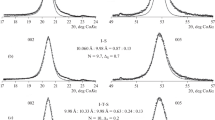Abstract
The boundary between diagenesis and metamorphism most likely involves the change of illite into mica. Observations of this change can be made using decomposed X-ray diffraction (XRD) spectra of illitic clay mineral assemblages in pelitic sedimentary rocks.
XRD analysis of the (003) diffraction peak of diagenetic illites indicates that there are 2 components, one of small coherent diffraction domains and another of larger domain size. Peak width, shape and position define these fractions. The smaller domain size material in diagenetic rocks is highly illitic (>95%) but contains some smectite layers and can be best described by Gaussian shapes. The grains with larger diffracting domains show no expanding layers.
Metamorphic illites (probably muscovites) show no smectite interlayers in any fraction. In the transition from sedimentary and diagenetic to metamorphic illites, new grains of smectite-free illite are formed at the expense of the older minerals. This suggests that the new metamorphic minerals are recrystallized phases. Metamorphism of illites then produces new mica phases.
Similar content being viewed by others
References
Dalla Torre M, Livi, KJT, Veblen RV, Frey M. 1996. White mica evolution from phengite to muscovite in shales and shale matrix melange, Diablo Range, California. Contrib Mineral Petrol 123:390–405.
Dunoyer de Segonzac G. 1970. The transformation of clay minerals during diagenesis and low-grade metamorphism: A review. Sedimentology 15:281–346.
Eberl DD, Środoń J. 1988. Ostwald ripening and interparticle-diffraction effects for illite crystals. Am Mineral 73:1335–1345.
Frey M. 1987a. The reaction isograd kaolinite quartz = pyrophyllite H2O, Helvetic Alps, Switzerland. Schweiz Min Petr Mitt 67:1–11.
Frey M. 1987b. Very low grade metamorphism of clastic sedimentary rocks. In: Frey M, editor. Low-temperature metamorphism. Glasgow: Blackie. p 9–58.
Gharrabi M, Velde B. 1995. Clay mineralogy evolution in the Illinois Basin and its causes. Clay Miner 30:353–364.
Kisch HJ. 1987. Correlation between indicators of very low-grade metamorphism. In: Frey M, editor. Low temperature metamorphism. London: Blackie. 552 p.
Kisch H. 1990. Calibration of the anchizone: A critical comparison of illite “crystallinity” scales used for definition. J Meta Geol 8:31–46.
Kübler B. 1968. Evaluation quantitative du métamorphisme par la cristallinité de l’illite. Bull Centre Rech Pau-SNAP 2, 2:385–397.
Lanson B. 1990. Mise en évidence des mécanismes réaction-nels des interstratifiés illite/smectite au cours de la diage-nese [thesis]. Paris: Université de Paris VI. 366 p.
Lanson B, Besson G. 1992. Characterisation of the end of smectite-to-illite transformation: Decomposition of X-ray patterns. Clays Clay Miner 40:40–52.
Lanson B, Champion D. 1991. The I-S-to-illite reaction in late stage diagenesis. Am J Sci 291:473–506.
Lanson B, Velde B. 1992. Decomposition of X-ray diffraction patterns: A convenient way to describe complex diagenetic evolution. Clays Clay Miner 40:629–643.
Merriman RJ, Roberts B, Peacor DR. 1990. A transmission electron microscope study of white mica crystallite size distribution in a mudstone to slate transitional sequence, North Wales, UK. Contrib Mineral Petrol 106:27–40.
Meunier A, Velde B. 1989. Solid solutions in I-S mixed layers and illite. Am Mineral 74:1106–1112.
Moore DM, Reynolds RC. 1989. X-ray diffraction identification and analysis of clay minerals. Oxford: Oxford Univ Pr. 322 p.
Paradis S, Velde B, Nicot E. 1983. Chloritôid-pyrophyllite-rectorite facies rocks from Brittany, France. Contrib Mineral Petrol 83:342–347.
Primmer TJ. 1985. A transition from diagenesis to greenshist facies within a major Varsican fold/thrust complex in southwest England. Mineral Mag 49:365–374.
Reynolds RC. 1980. Interstratified clay minerals. In: Brindley GW, Brown G, editors. Crystal structures of clay minerals and their X-ray identification. London: Mineral Soc. Memoir 4. p 249–359.
Robinson D, Warr LN, Bevins RE. 1990. The illite “crystal-linity” technique: A critical appraisal of its precision. J Meta Geol 8:333–344.
Robinson D. 1987. Transition from diagenesis to metamor-phism in extensional and collision settings. Geology 15: 866–869.
Sagon J-P. 1976. Contribution à l’étude géologique de la partie orientale du bassin de Câteaulin (Massif Armorican): Stratigraphie, volcanisme, métamorphisme tectonique [Thèse de Doctorat d’Etat]. Paris: Universite de Paris VI. 671 p.
Stern WB, Mullis J, Rahn M, Frey M. 1991. Deconvolution of the first “illite” basal reflection. Schweiz Min Petog Mitt 71:453–462.
Velde B. 1968. The effect of chemical reduction on the stability of pyrophyllite and kaolinite in pelitic rocks. J Sed Petrol 39:13–16.
Velde B, Brusewitz A-M. 1986. Compositional variation in component layers in natural illite/smectite. Clays Clay Miner 34:651–657.
Velde B, Vasseur G. 1992. Estimation of the diagenetic smectite to illite transformation in time-temperature space. Am Mineral 77:967–976.
Wang H, Sterni WB, Frey M. 1995. Deconvolution of the X-ray “illite” 10A complex: A case study of Helvetic sediments from eastern Switzerland. Schweiz Min Pet Mitt 75: 187–199.
Warr LN, Primmer TJ, Robinson D. 1991. Varsican very low-grade metamorphism in southwest England: A diastather-mal and thrust-related origin. J Meta Geol 9:751–764.
Warr LN, Rice, AHN. 1994. Interlaboratory standardization and calibration of clay mineral crystallinity and crystallite size data. J Meta Geol 12:141–152.
Weaver CE. 1989. Clays, muds and shales. Developments in sedimentology. Amsterdam: Elsevier. 556 p.
Winkler HGF. 1976. Petrogenesis of metamorphic rocks. Berlin: Springer Verlag. 334 p.
Author information
Authors and Affiliations
Rights and permissions
About this article
Cite this article
Gharrabi, M., Velde, B. & Sagon, J.P. The Transformation of Illite to Muscovite in Pelitic Rocks: Constraints from X-Ray Diffraction. Clays Clay Miner. 46, 79–88 (1998). https://doi.org/10.1346/CCMN.1998.0460109
Received:
Accepted:
Published:
Issue Date:
DOI: https://doi.org/10.1346/CCMN.1998.0460109




